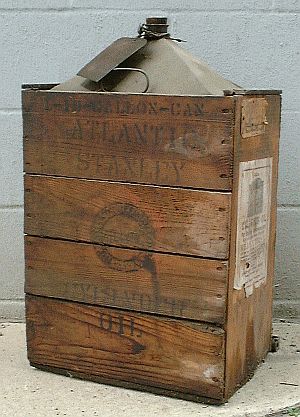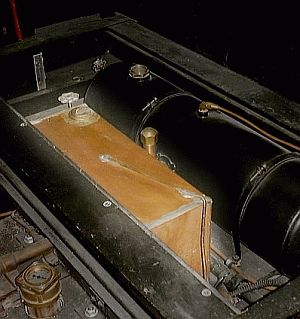|
 Steam oil is often referred to as cylinder oil and
compounded steam cylinder oil as its primary use is to lubricate the valves
and cylinders of steam engines. Steam cylinder oil provides a
lubricating film to the engine steam admission valves (D-shaped valves in a
Stanley engine) and the pistons within the cylinder walls. Both the
valves and the pistons are metal to metal sliding interfaces. Steam
oil must possess unique characteristics to allow it to mix with superheated
steam, saturated steam, and hot water (condensate). Steam oils are
manufactured primarily from mineral oils and are of viscosities equal to or
greater than 600-weight oils. Steam oil is often referred to as cylinder oil and
compounded steam cylinder oil as its primary use is to lubricate the valves
and cylinders of steam engines. Steam cylinder oil provides a
lubricating film to the engine steam admission valves (D-shaped valves in a
Stanley engine) and the pistons within the cylinder walls. Both the
valves and the pistons are metal to metal sliding interfaces. Steam
oil must possess unique characteristics to allow it to mix with superheated
steam, saturated steam, and hot water (condensate). Steam oils are
manufactured primarily from mineral oils and are of viscosities equal to or
greater than 600-weight oils.
Stanley instructions and manuals
recommended the use of Harris Superheat Steam Cylinder Oil furnished by the
A. W. Harris Oil Company of Providence, Rhode Island or Oilzum High Pressure
Superheated Steam Cylinder Oil manufactured by the White and Bagley company
of Worchester, Massachusetts for use with non-condensing cars. When
the condensing cars began to be manufactured it was necessary to change the
consistency of the oil and Harris Condensing Steam Cylinder Oil from the A.
W. Harris Company was recommended. Near the end of production Stanley
changed to using Atlantic 20th Century Cylinder Oil manufactured by the
Atlantic Refining Company.
The quantity of oil delivered to the
steam engine cylinders of a non-condensing car was not too important as the
oil did not return to the boiler. The only condition to be avoided
with a non-condensing car was insufficent oil being fed to the engine.
When the condensing cars were introduced the oil added to the steam and sent
to the engine for lubrication returned to the water tank and eventually the
boiler. Thus it became important to limit the oil used to only what
was necessary for proper engine lubrication. The plunger type oil pump was found difficult to adjust to deliver the
very small quantity of oil acceptable as a minimum to the engine.
Consequently the oil was heavily diluted with kerosene (85% Kerosene to 15%
oil according to Atlantic). Now the pump could deliver oil in larger
volumes and only a minimum amount of the oil actual oil would find itís way
back to the boiler. On the later condenser models such as 740, 745
etc; an entirely redesigned pump with ratcheting type pump was used which
permitted very fine adjustment. With this pump, which is mounted in
the oil tank, undiluted oil is used.
 Heating raw petroleum collected from
oil wells and drawing off the vaporized gasses at different temperatures
provides various products such as gasoline, kerosene, and diesel fuels as
well as lubricating oils also known as mineral oils. Water will displace
most oils, with the exception of animal based oils, and consequently special
compounded oils that will lubricate in the presence of water are needed for
successful steam engine operation. Modern steam oils contain 4% tallow by
volume that comes from animals. Animal oil based tallow is produced by
heating or boiling animal carcasses, and collecting the liquid residue. It
is this tallow oil that makes steam oil work in the hostile internal
environment of the steam engine. In practice the petroleum producers place
several compounds in steam oil to help stabilize viscosity and lubricity;
hence the name compounded steam oil. Steam oils are manufactured in
several blends depending on the temperature of the steam they are to be used
with. Heating raw petroleum collected from
oil wells and drawing off the vaporized gasses at different temperatures
provides various products such as gasoline, kerosene, and diesel fuels as
well as lubricating oils also known as mineral oils. Water will displace
most oils, with the exception of animal based oils, and consequently special
compounded oils that will lubricate in the presence of water are needed for
successful steam engine operation. Modern steam oils contain 4% tallow by
volume that comes from animals. Animal oil based tallow is produced by
heating or boiling animal carcasses, and collecting the liquid residue. It
is this tallow oil that makes steam oil work in the hostile internal
environment of the steam engine. In practice the petroleum producers place
several compounds in steam oil to help stabilize viscosity and lubricity;
hence the name compounded steam oil. Steam oils are manufactured in
several blends depending on the temperature of the steam they are to be used
with.
Steam pressure and temperature at the
cylinder is the primary consideration in selecting the correct steam
cylinder oil. As a general rule the higher the steam pressure and
temperature, the greater the need for a higher viscosity of oil, and the
lower the amount of compounding which is required. If temperatures and
pressures are relatively low, then lighter viscosity oils with high
percentages of compounding are most effective. Other mineral based oils such
as internal combustion engine oil and machine oil must be avoided because
they will not be able to maintain their lubricating properties in the
presence of hot water and superheated steam. The result will be
metal-to-metal contact between the internal parts of the steam engine
assembly, which will result in the scoring and galling of mating wear
surfaces.
For additional information on steam
cylinder oils see the Exxon-Mobil website.
|

 Steam oil is often referred to as cylinder oil and
compounded steam cylinder oil as its primary use is to lubricate the valves
and cylinders of steam engines. Steam cylinder oil provides a
lubricating film to the engine steam admission valves (D-shaped valves in a
Stanley engine) and the pistons within the cylinder walls. Both the
valves and the pistons are metal to metal sliding interfaces. Steam
oil must possess unique characteristics to allow it to mix with superheated
steam, saturated steam, and hot water (condensate). Steam oils are
manufactured primarily from mineral oils and are of viscosities equal to or
greater than 600-weight oils.
Steam oil is often referred to as cylinder oil and
compounded steam cylinder oil as its primary use is to lubricate the valves
and cylinders of steam engines. Steam cylinder oil provides a
lubricating film to the engine steam admission valves (D-shaped valves in a
Stanley engine) and the pistons within the cylinder walls. Both the
valves and the pistons are metal to metal sliding interfaces. Steam
oil must possess unique characteristics to allow it to mix with superheated
steam, saturated steam, and hot water (condensate). Steam oils are
manufactured primarily from mineral oils and are of viscosities equal to or
greater than 600-weight oils.
 Heating raw petroleum collected from
oil wells and drawing off the vaporized gasses at different temperatures
provides various products such as gasoline, kerosene, and diesel fuels as
well as lubricating oils also known as mineral oils. Water will displace
most oils, with the exception of animal based oils, and consequently special
compounded oils that will lubricate in the presence of water are needed for
successful steam engine operation. Modern steam oils contain 4% tallow by
volume that comes from animals. Animal oil based tallow is produced by
heating or boiling animal carcasses, and collecting the liquid residue. It
is this tallow oil that makes steam oil work in the hostile internal
environment of the steam engine. In practice the petroleum producers place
several compounds in steam oil to help stabilize viscosity and lubricity;
hence the name compounded steam oil. Steam oils are manufactured in
several blends depending on the temperature of the steam they are to be used
with.
Heating raw petroleum collected from
oil wells and drawing off the vaporized gasses at different temperatures
provides various products such as gasoline, kerosene, and diesel fuels as
well as lubricating oils also known as mineral oils. Water will displace
most oils, with the exception of animal based oils, and consequently special
compounded oils that will lubricate in the presence of water are needed for
successful steam engine operation. Modern steam oils contain 4% tallow by
volume that comes from animals. Animal oil based tallow is produced by
heating or boiling animal carcasses, and collecting the liquid residue. It
is this tallow oil that makes steam oil work in the hostile internal
environment of the steam engine. In practice the petroleum producers place
several compounds in steam oil to help stabilize viscosity and lubricity;
hence the name compounded steam oil. Steam oils are manufactured in
several blends depending on the temperature of the steam they are to be used
with.